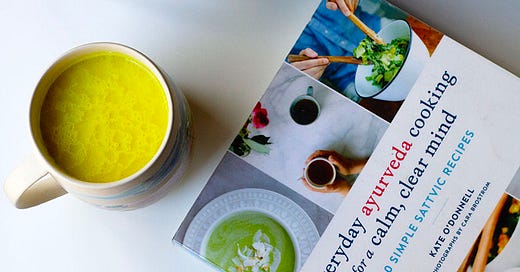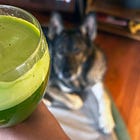Yes indeed, it’s that time of the year again, where I perhaps somewhat foolishly attempt to do some sort of cleanse – for science, or perhaps more rightly, content.
As with all the best ideas, this one stemmed first and foremost from a book. Specifically, Everyday Ayurveda cookbook for a calm, clear mind: 100 simple sattvic recipes by Kate O'Donnell.
I first really learned about Ayurveda while I was completing my 200 hour yoga teacher training in 2023. I found it so interesting and was keen to know more about this ancient health science.
A sattvic diet consists of light and healthy foods, that are mostly vegetarian – they’re thought to increase mental clarity, energy and overall happiness.
So a sattvic cleanse is essentially a diet-led cleanse that suggests you’ll experience the following upon completion:
an absence of brain fog
sleeping well and feeling refreshed upon waking
a calm emotional state
the ability to gift attention to loved ones and nature
sustained energy throughout the day
less procrastination
an active desire for ‘sattvic’ activities, such as crafting, reading and spending time outdoors.
This all sounds most splendid. What could go wrong?
What is Ayurveda?
A sister science to that of yoga and just as ancient, Ayurveda (pronounced EYE-yer-VAY-da) is essentially a health science (India’s own indigenous health system), with the word itself being roughly translated to ‘science of life’.
The philosophy behind it is simple – it aims to unite mind, body and spirit, often using the movement and breathing (pranayama) in yoga to access energy, which is then circulated around the body.
Ayurveda is heavily linked to the seasons – and so promotes seasonal eating, something entirely foreign to our modern, convenience-led lives.
There is also an emphasis on cleansing, a healthy ‘sattvic’ diet and rest. As we have discussed before in this newsletter, things that seem simple but are hard to achieve in modern life, particularly rest.
Ayurveda is also closely connected to what are known as the doshas – three element driven energies that can be found in the body:
Vata – energy of air and movement
Pitta – energy of fire and transformation
Kapha – energy of earth and cohesion.
While it’s believed that most people lean a little towards one dosha in particular (Ayurveda’s very own Myers-Briggs test), in an ideal world you’d have all three doshas in balance. Or if you were more pitta-inclined for example, you’d work towards rounding things out with a little more kapha and grounding in your life.
It’s all kind of endlessly interesting and indeed, if you’re interested in learning more about Ayurveda, specifically the mental benefits, I recommend reading Ayurveda and the Mind by David Frawley.
Science is also having a delightful time delving into the connection between the brain and the gut (read: Gut: the inside story of our body's most under-rated organ by Giulia Enders for more on this), but it makes sense, doesn’t it? We generally feel good when we eat wholefoods; a diet rich with seasonal fruit and vegetables, not laden down with sugar, artificial flavours, dairy and the like.
As per the 3-day juice cleanse I undertook last year, I’ll be writing this in diary form. This will be available to read for all What’s Cooking paid subscribers. To have a bit of a nose around yourself, consider upgrading your subscription.
While I’ve crafted this as a gentle investigation, if talk of diet is upsetting or triggering for you in any way, please skip this edition. And further noting that I am not a nutritionist, dietician or any sort of medical expert – just a fool on the internet, sharing their thoughts and feelings. Thank you.
And with that, let’s jump into the wonderful world of Ayurveda.
Keep reading with a 7-day free trial
Subscribe to What's Cooking with Celine to keep reading this post and get 7 days of free access to the full post archives.




